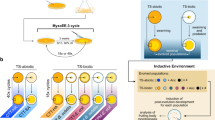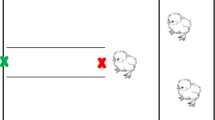Abstract
Warning coloration signals are a familiar and conspicuous phenomenon in nature. However, the fundamental question of how warning signals initially evolved remains unanswered. For an unpalatable prey to evolve a signal to indicate its unprofitability, a rare and conspicuous mutant in a population of unpalatable cryptic prey must overcome a double disadvantage: a greater risk of being detected (as a result of being more conspicuous) and of being attacked (because its rarity results in a decreased association with aversion) by a predator1,2. Although the prior evolution of prey gregariousness may help warning signals to evolve3,4,5,6,7,8, such an evolutionary order may not always be the case4,9,10,11. Here we present a theoretical model that describes a mechanism for the evolution of warning signals without having to invoke gregariousness. Specifically, a predator's generalization of stimulus in associative learning, with a ‘peak shift’ towards greater conspicuousness5,12,13,14,15, allows a warning signal to evolve when the prey population density exceeds a threshold. Once a warning signal starts to evolve, it continues to grow; the resulting, evolutionarily stable16 conspicuousness of prey is discontinuously greater than that of the original cryptic prey, drawing an unambiguous distinction in their appearance.
This is a preview of subscription content, access via your institution
Access options
Subscribe to this journal
Receive 51 print issues and online access
$199.00 per year
only $3.90 per issue
Buy this article
- Purchase on Springer Link
- Instant access to full article PDF
Prices may be subject to local taxes which are calculated during checkout


Similar content being viewed by others
References
Guilford, T. The evolution of conspicuous coloration. Am. Nat. 131 , S7–S21 (1988).
Guilford, T. in Insect Defenses (eds Evans, D. L. & Schmidt, J. O.) 23– 61 (State Univ. New York Press, (1990)).
Fisher, R. A. The Genetical Theory of Natural Selection (Clarendon, Oxford, ( 1930)).
Harvey, P. H., Bull, J. J. & Paxton, R. J. Why some insects look pretty nasty. New Sci. 97, 26–27 ( 1983)).
Leimar, O., Enquist, M. & Sillén-Tullberg, B. Evolutionary stability of aposematic coloration and prey unprofitability: a theoretical analysis. Am. Nat. 128, 469–490 (1986).
Mallet, J. & Singer, M. Individual selection, kin selection, and the shifting balance in the evolution of warning colours: the evidence from butterflies. Biol. J. Linn. Soc. 32, 337–350 (1987).
Gagliardo, A. & Guilford, T. Why do warning-coloured prey live gregariously? Proc. R. Soc. Lond. B 251, 69–74 (1993).
Alatalo, R. V. & Mappes, J. Tracking the evolution of warning signals. Nature 382, 708– 710 (1996).
Sillén-Tullberg, B. Evolution of gregariousness in aposematic butterfly larvae: a phylogenetic analysis. Evolution 42, 293– 305 (1988).
Tullberg, B. S. & Hunter, A. F. Evolution of larval gregariousness in relation to repellent defences and warning coloration in tree-feeding Macrolepidoptera: a phylogenetic analysis based on independent contrasts. Biol. J. Linn. Soc. 57, 253– 276 (1996).
Sillén-Tullberg, B. The effect of biased inclusion of taxa on the correlation between discrete characters in phylogenetic trees. Evolution 47, 1182–1191 (1993).
Weary, D. M., Guilford, T. C. & Weisman, R. G. Aproduct of discriminative learning may lead to female preferences for elaborate males. Evolution 47, 333–336 (1993).
Leimar, O. & Tuomi, J. Synergistic selection and graded traits. Evol. Ecol. 12, 59–71 (1998).
Gamberale, G. & Tullberg, B. S. Evidence for a peak-shift in predator generalization among aposematic prey. Proc. R& Soc. Lond. B 263, 1329–1334 ( 1996).
Hanson, H. M. Effects of discrimination training on stimulus generalization. J. Exp. Psychol. 58, 321–334 (1959).
Maynard Smith, J. Evolution and the Theory of Games (Cambridge Univ. Press, Cambridge, (1982)).
Gittleman, J. L. & Harvey, P. H. Why are distasteful prey not cryptic? Nature 286, 149– 150 (1980).
Roper, T. J. & Redston, S. Conspicuousness of distasteful prey affects the strength and durability of one-trail avoidance learning. Anim. Behav. 35, 739–747 (1987).
Owen, R. E. & Owen, A. R. G. Mathematical paradigms for mimicry: recurrent sampling. J. Theor. Biol. 109, 217–247 (1984).
Guilford, T. Evolutionary pathways of aposematism. Oecologica 11 , 835–841 (1990).
Endler, J. A. Frequency-dependent predation, crypsis and aposematic coloration. Phil. Trans. R. Soc. Lond. B 319, 505– 523 (1988).
Karlin, S. A First Course in Stochastic Processes (Academic, New York, ( 1969)).
Schuler, W. & Roper, T. J. Responses to warning coloration in avian predators. Adv. Study Behav. 21, 111–146 (1992).
Acknowledgements
We thank N. Yamamura for discussions; O. Takeyama for technical advice; and J.Lawton and the NERC Centre for Population Biology for hospitality and discussions offered to M.H. in finalizing the manuscript. This work was supported by an MESSC grant to M.H.
Author information
Authors and Affiliations
Corresponding author
Rights and permissions
About this article
Cite this article
Yachi, S., Higashi, M. The evolution of warning signals. Nature 394, 882–884 (1998). https://doi.org/10.1038/29751
Received:
Accepted:
Issue Date:
DOI: https://doi.org/10.1038/29751
This article is cited by
-
Etmopteridae bioluminescence: dorsal pattern specificity and aposematic use
Zoological Letters (2019)
-
Postdiscrimination Gradients With Familiar and Unfamiliar Faces
The Psychological Record (2015)
-
Can aposematic signals evolve by gradual change?
Nature (1999)
Comments
By submitting a comment you agree to abide by our Terms and Community Guidelines. If you find something abusive or that does not comply with our terms or guidelines please flag it as inappropriate.



